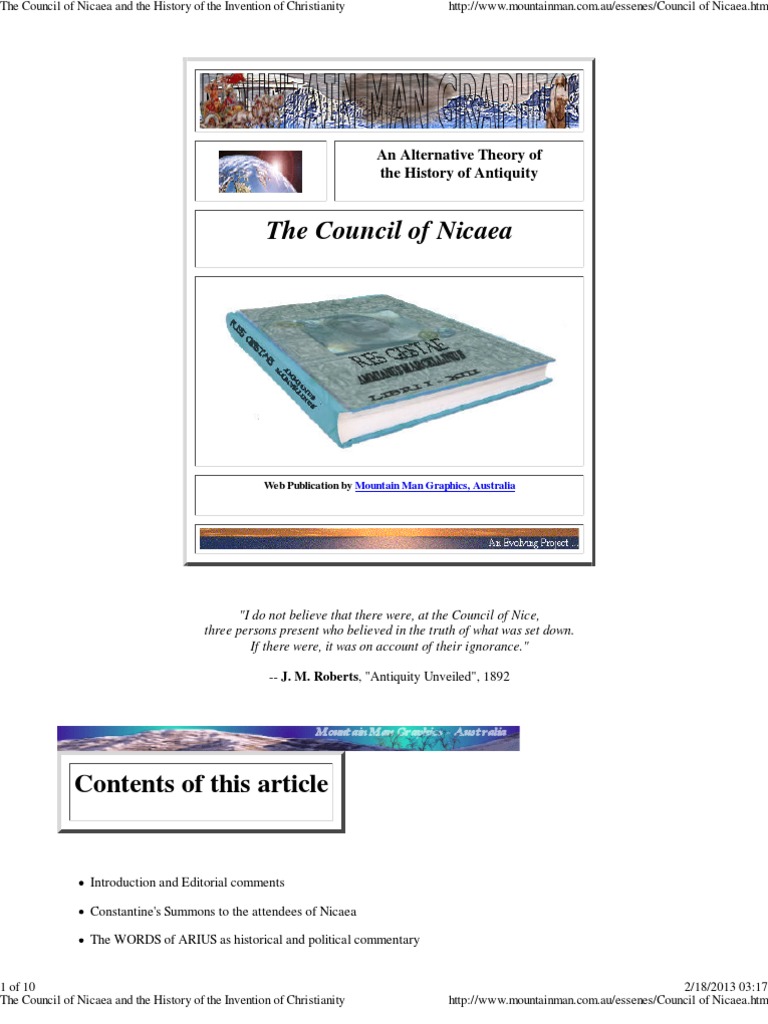The Council of Nicaea, convened in 325 CE, represents a watershed moment in the annals of early Christianity, marking the first ecumenical council that sought to address fundamental doctrinal disputes that had emerged within the burgeoning faith. This assembly, held in the city of Nicaea (modern-day İznik, Turkey), gathered bishops from across the Christian world under the auspices of Emperor Constantine. His intention was not merely ecclesiastical; it was also political. By fostering unity among Christians, Constantine aimed to consolidate his power and stabilize the Roman Empire, which was rife with internal strife and theological discord.
This gathering comprised approximately 318 bishops, many of whom were ardent defenders of the faith. The council itself was born from a pressing theological quandary: the nature of Christ. The debate primarily revolved around the Arian controversy instigated by Arius, a priest from Alexandria who posited that Jesus Christ, the Son of God, was distinct and subordinate to God the Father, thus challenging the notion of the Trinity—that the Father, Son, and Holy Spirit are of one essence. This essential discord prompted a re-evaluation of Christological doctrine within Christian theology.
The Council of Nicaea resulted in the formulation of the Nicene Creed, a defining statement of Christian belief that asserts the consubstantiality of the Son with the Father. “We believe in one Lord, Jesus Christ, the only begotten Son of God, begotten of the Father before all worlds; Light of Light, very God of very God; begotten, not made, being of one substance with the Father.” This proclamation was pivotal in crystallizing the doctrine of the Trinity, ultimately asserting that Christ, though incarnate, is fully divine and coeternal with the Father.
A lingering fascination around the Council of Nicaea arises from its implications, not merely in theological terms but also in its broader sociopolitical context. For many, it represents the intersection of faith and imperial power, a phenomenon that continues to echo in discussions about the church’s authority and its relationship with the state. The subsequent adoption of Christianity as the state religion by Constantine’s successors rendered the church an instrumental entity within the realm of Roman governance.
Despite the Council’s intentions to foster unity, the doctrinal decisions made at Nicaea did not quell the flames of controversy. The Arian position continued to garner support in various regions, leading to subsequent controversies and additional councils. The conflict heightened, eventually culminating in a series of theological and political battles that characterized the church’s evolution throughout the ensuing centuries.
Additionally, it is noteworthy that the Council of Nicaea also addressed other ecclesiastical matters, including the date of Easter, which had become a contentious issue among Christians. The council established a formula for the annual celebration of Easter, binding it to the spring equinox and thereby ensuring a unified observance that transcended regional variations. This decision played a crucial role in fortifying ecclesiastical identity during a time of rampant theological plurality.
The aftermath of Nicaea ushered in an era marked by the circulation of creeds and canons, as various factions grappled for authority and legitimacy. The Nicene Creed, while initially contentious, gradually gained acceptance across Christian communities, and it has persisted as a foundational tenet of belief for many Christian denominations throughout history. This remarkable durability illustrates the lasting impact of the Council and its pivotal role in shaping Christian orthodoxy.
Moreover, the theological ramifications of the Council of Nicaea resonate with contemporary debates on doctrinal purity and authority. In a modern context, one can observe a parallel in contemporary Christianity—the tension between traditionalist positions and more liberal interpretations of faith. Much like the early church grappled with the implications of the Nicene Creed, today’s believers navigate the complexities of interpretation, belief, and practice, often seeking to reconcile age-old doctrines with contemporary sensibilities.
By delving into these historical intricacies, one gains a deeper appreciation for the Council of Nicaea and its critical role in shaping not only early Christian doctrine but also the sociopolitical landscape of the Roman Empire. The decisions made during this pivotal assembly transformed theological discourse and influenced the Christian experience for generations to come. Furthermore, the Council was a defining moment not only for the church but also for the development of Western thought and philosophy.
In conclusion, the Council of Nicaea serves as a salient reminder of the complexities inherent in religious belief systems. It encapsulates a significant epoch when faith, doctrine, and politics intertwined, creating a legacy that continues to provoke inquiry and reflection. As modern Christians grapple with their own beliefs and interpretations, the echoes of Nicaea resonate, inviting deeper exploration into the history and development of their faith. Thus, the legacy of the Council persists, not merely as an artifact of church history but as a living dialogue within the ongoing narrative of Christianity itself.



